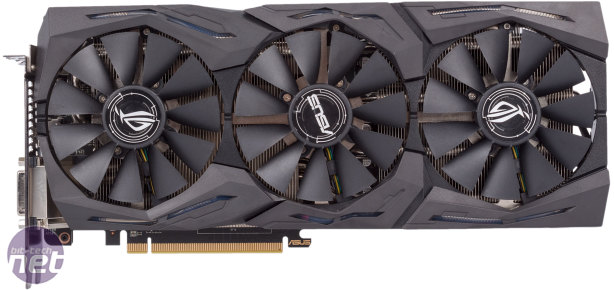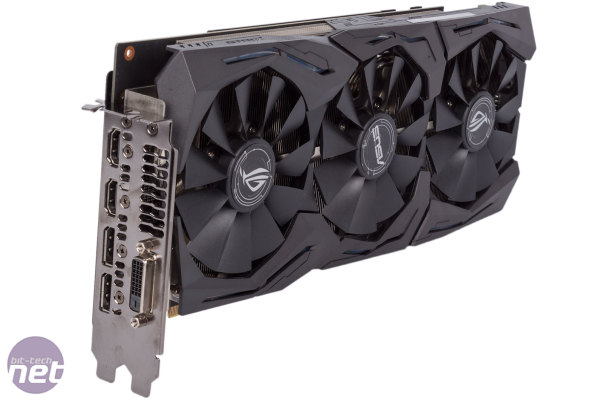Performance Analysis
At 1080p, the RX 480 8GB is a mighty GPU, and this Asus Strix card demonstrates that nicely. Performance is consistently smooth, and in half of our games tests at this resolution the card's minimum frame rate is well above 60fps. If this is the resolution you play at, this card will let you crank everything up to the max and enjoy a great gameplay experience. If 1440p is your aim, however, that's not quite the case. Five of our six games have minimums of 30fps or more, but Deus Ex: Mankind Divided sees a 27fps minimum. This still counts as technically playable, but it does indicate that with this many pixels, some of the more demanding (or at least less optimised) titles may need turning down to 'High' instead of 'Ultra' – rarely a huge sacrifice, but one worth pointing out.Regarding other cards, Asus here trades blows with a number of cards, including the GTX 1060 6GB and RX 480 4GB. Over the GTX 1060 Founders Edition, this card is five percent faster on average, but it's not a consistent lead – it loses out in Fallout 4 and is only a fraction quicker in The Witcher 3, for example. These are DirectX 11 titles, however, and in DirectX 12 games it's ahead, and it enjoys a considerable advantage in Doom running with Vulkan, with an average frame rate at 1440p that's 20 percent quicker than Nvidia. That said, Nvidia's card here is a reference clocked model, so the differences would be even slimmer when comparing against an overclocked GTX 1060 6GB. Asus is unable to beat Sapphire's RX 480 Nitro OC 8GB, with the two cards being neck and neck across the board, but it does trump the 4GB card, albeit only by four percent on average.
While Asus cannot really control how efficient AMD GPUs are, the parts of this card that it is responsible for do appear to be pretty efficient. In our tests, using this card saw peak power consumption fall by 45W compared to the Sapphire RX 480 Nitro OC 8GB, which is pretty remarkable given that this card actually has an extra fan too. It even consumes a bit less than the Sapphire RX 470 Nitro OC 4GB. This would suggest that there is truth in Asus's claims about its Super Alloy Power II components. We're not aware of AMD binning GPUs for this card with power efficiency targets in mind, although it's a possibility at least.
Still, while this does look good for Asus, it doesn't change the fact that the GTX 1060 is clearly the card you'd go for if efficiency was a concern. As such, we think it's a shame Asus didn't increase the power limit of this card to allow it to reach its peak boost clock of 1,330MHz constantly, or at least more often. Instead, we found it to be around 1,250MHz on average, although there was a lot of variation. It's easy for users to manually up the power limit, of course, but we still think it would have been a nice touch – most enthusiasts will be more concerned by GPU-Z readings than those of a wattmeter.
Unsurprisingly, the DirectCU III cooler is rather effective. The recorded delta T of 49°C is 10°C cooler than we saw with the reference card. Noise was considerably reduced too, although we still think Asus has been a bit overly aggressive with its fan profiles in pursuit of really low temperatures. The fans span at 35 percent, around 1,350 RPM, to maintain this performance, and while quiet this meant the cooler was still audible under load. Given the size of it, we were hoping for near-silence. It's easy enough to manually limit the speeds, and there's clearly ample headroom to do so without worrying, but the default mode isn't the approach we'd have picked.
Although we only increased the core by 20MHz when overclocking, the unlocked power limit meant that performance improved by between four and eight percent (the 11 percent memory overclock also would have been helping). The RX 480 is never going to catch the GTX 1070 (nor would the GTX 1060), but free performance is free performance and although power consumption did increase by 35W the limited impact on fan speed and temperatures means it really is free here. That said, if you have more luck overclocking and especially if you put additional voltage through the GPU, you may notice the fans getting louder to compensate.
Conclusion
If £300 or so is your limit for a GPU upgrade, you're currently looking at either the GTX 1060 6GB or RX 480 8GB, as the GTX 1070 requires substantially more investment. Performance differences vary from game to game but ultimately don't amount to much, but the RX 480 8GB makes a decent case for itself, especially in newer APIs like DirectX 12 and Vulkan where it appears to have an advantage. It also has more memory too, although it's never easy to gauge how important that'll be in the long run.Clearly, then, the RX 480 8GB is worth considering, but what about this one? The obvious thing to note is that this isn't the card for you if you're looking to maximise the bang for your buck. It is overclocked, yes, but only by a small amount that isn't going to make a difference of more than a few fps over most over cards that are £50 cheaper. You might even consider looking at the RX 480 4GB, which still appears to be the best bang-for-buck card on the market.
However, the Strix brand has never been about that. That's not to say Asus has free reign to charge what it likes, but this is clearly a premium product geared towards enthusiasts who want something a little more special and Asus definitely does a lot to appease such buyers. For example, there's the upgraded VRM components, which do appear to actually make some difference efficiency-wise; the dual HDMI outputs is a neat idea, although admittedly not one that's unique to Asus; and the RGB lighting while again not unique is very well implemented, with the backplate lighting being particularly awesome. The cooler is also semi-passive and very effective at what it does, while FanConnect is a cool feature that'll appeal to those who like obsessing over the intricacies of their system. The build quality is also excellent all round.
It's not a perfect card, however. A higher overclock that put the card at the top of the pack would be nice, as would a memory overclock. A metal cooler shroud would further improve build quality, and the memory chips could be more adequately cooled. We also think the card could be configured more effectively out of the box. First, by getting rid of the power limit in OC mode so that maximum boost frequency could be maintained and second by gearing the fan profile more towards silence than performance.
Overall, however, it's hard to deny the quality of what's on offer here. It's pricey, but not excessively so, at least if you're the type for whom the extras are of real benefit. If that's you, this card comes recommended, though don't forget about the slightly cheaper non-overclocked version either.


MSI MPG Velox 100R Chassis Review
October 14 2021 | 15:04












Want to comment? Please log in.